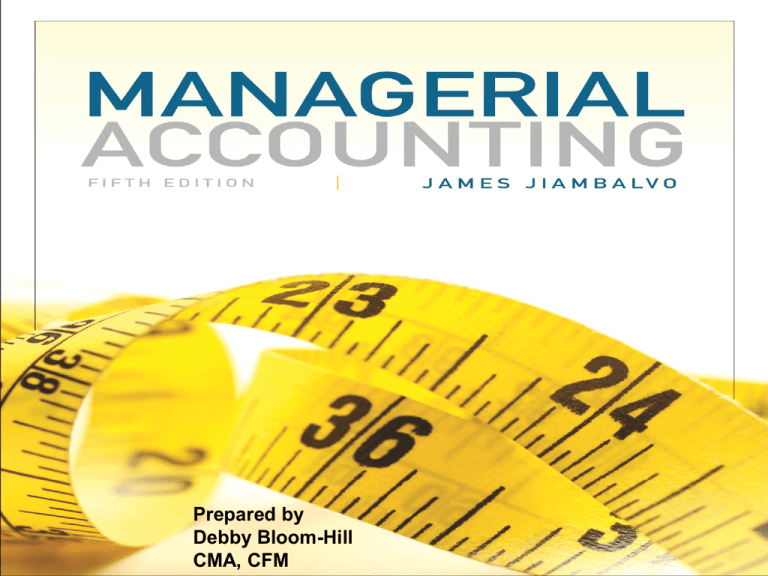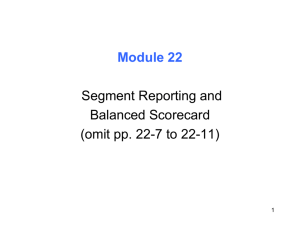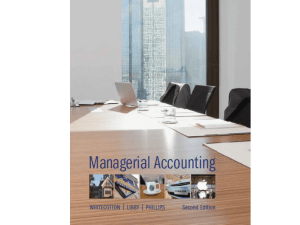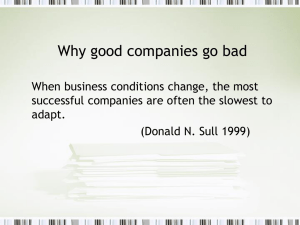
Prepared by
Debby Bloom-Hill
CMA, CFM
CHAPTER 12
Decentralization
and
Performance Evaluation
Slide 12-2
Decentralized Organizations
As firms increase in size and
complexity, business segments or
subunits are organized
The managers of the segments are
granted decision making authority so
that the firm will function efficiently
and effectively
Firms that grant substantial decision
making authority to the managers of
subunits are referred to as
decentralized organizations
Slide 12-3
Learning objective 1: List and explain the advantages and
disadvantages of decentralization
Decentralized Organizations
Most firms are neither totally
centralized nor totally decentralized
Typically, decentralization is a matter
of degree
A firm is more decentralized if more
decision making authority is delegated
to sub-unit managers
Performance evaluation can be used to
ensure that managers make decisions
that are in the best interest of the entire
firm
Slide 12-4
Learning objective 1: List and explain the advantages and
disadvantages of decentralization
Decentralized Organizations
Slide 12-5
Learning objective 1: List and explain the advantages and
disadvantages of decentralization
Advantages of Decentralization
A primary reason is that subunit
managers have better information than
top management and can respond quicker
to changing circumstances
Other reasons include
Some firms decentralize because they
believe that managers are more motivated
and work harder
Decentralized organizations provide
excellent training for future top-level
executives
Slide 12-6
Learning objective 1: List and explain the advantages and
disadvantages of decentralization
Disadvantages of Decentralization
Decentralization can cause problems
It may result in a costly duplication of
activities
Managers may pursue personal goals
that are incompatible with the goals of
the company as a whole
This problem is called goal congruence
To control goal congruence, companies
evaluate the performance of subunit
managers
Slide 12-7
Learning objective 1: List and explain the advantages and
disadvantages of decentralization
All of the following are advantages of
decentralization except:
a. Faster response to changing
circumstances
b. Costly duplication of activities
c. Increased motivation of managers
d. Better information, leading to superior
decisions
Answer: b
Costly duplication of activities
Slide 12-8
Learning objective 1: List and explain the advantages and
disadvantages of decentralization
Evaluating Subunits
Evaluation of subunits is undertaken
to identify successful operations and
areas needing improvement
Top management may perform
incremental analysis to determine:
Whether a successful operation should
be expanded
Whether an unsuccessful operation
should be eliminated or improved
Slide 12-9
Learning objective 2: Explain why companies evaluate the
performance of subunits and subunit managers
Evaluating Subunit Managers
A company evaluates subunit
managers in order to motivate them to
take actions that maximize the value of
the firm
Reasons for evaluating subunit
managers:
Identifies successful operations and
areas needing improvement
Influences the behavior of managers
Slide 12-10
Learning objective 2: Explain why companies evaluate the
performance of subunits and subunit managers
Responsibility Accounting and
Performance Evaluation
Responsibility accounting is a technique
that holds managers responsible only for
costs and revenues that they can control
This idea should play a prominent role in
the design of accounting systems used to
evaluate managers
Costs and revenues are traced to the
organizational level where they can be
controlled
Slide 12-11
Learning objective 2: Explain why companies evaluate the
performance of subunits and subunit managers
Tracing Costs to Organizational
Levels
Slide 12-12
Learning objective 2: Explain why companies evaluate the
performance of subunits and subunit managers
Responsibility Centers
Responsibility centers are
organizational units responsible for
the generation of revenue and/or the
incurrence of costs
Responsibility centers typically are
classified as being
Cost centers
Profit centers, or
Investment centers
Slide 12-13
Learning objective 3: Identify cost centers, profit
centers, and investment centers
Cost Centers
A cost center is a subunit that has
responsibility for controlling costs but
does not have responsibility for
generating revenue
Most service departments are classified
as cost centers
The managers of these departments are
responsible for making sure their
services are provided at a reasonable
cost to the company
Slide 12-14
Learning objective 3: Identify cost centers, profit
centers, and investment centers
Cost Centers
A common approach to controlling
cost centers is to compare their actual
costs with standard or budgeted costs
If variances from standard are
significant, an investigation into the
activities of the cost center should be
undertaken to determine whether costs
are out of control
Other performance measures can be
used as well
Slide 12-15
Learning objective 3: Identify cost centers, profit
centers, and investment centers
Profit Centers
A profit center is a subunit that has
responsibility for generating revenues
as well as for controlling costs
Because both revenues and costs are
under the control of the profit center
manager, the performance of the profit
center can be evaluated in terms of
profitability
This motivates managers to focus their
attention on ways of maximizing profit
center profitability
Slide 12-16
Learning objective 3: Identify cost centers, profit
centers, and investment centers
Profit Centers
Companies use a variety of methods to
profit centers
Income earned in the current year may be
compared with an income target
Income earned may be compared with
income earned in the prior year
Some firms use relative performance
evaluation, which involves evaluating the
profitability of each profit center relative
to the profitability of similar profit centers
Slide 12-17
Learning objective 3: Identify cost centers, profit
centers, and investment centers
Investment Centers
An investment center is a subunit that
is responsible for generating revenue,
controlling costs, and investing in
assets
An investment center is changed with
earning income consistent with the
amount of assets invested in the
segment
Slide 12-18
Learning objective 3: Identify cost centers, profit
centers, and investment centers
Investment Centers
If the manager can influence decisions
affecting investment in divisional
assets, the division should be
considered an investment center
Managers play a major role in the
determining the level of inventory,
accounts receivable and equipment
It seems reasonable to hold them
responsible for earning a return on
these assets
Slide 12-19
Learning objective 3: Identify cost centers, profit
centers, and investment centers
An investment center is responsible for:
a.
b.
c.
d.
Investing in long term assets
Controlling costs
Generating revenues
All of the above
Answer:
d. All of the above
Slide 12-20
Learning objective 3: Identify cost centers, profit
centers, and investment centers
Profit centers are often evaluated using:
a.
b.
c.
d.
Investment turnover
Income targets or profit budgets
Return on investment
Residual income
Answer:
b. Income targets or profit budgets
Slide 12-21
Learning objective 3: Identify cost centers,
profit centers, and investment centers
Evaluating Investment Centers
With ROI
One of the primary tools for evaluating
the performance of investment centers
is return on investment, or ROI
ROI is calculated as the ratio of
investment center income to invested
capital
Focuses management’s attention on
both income (numerator) and the level
of investment (denominator)
Slide 12-22
Learning objective 4: Calculate and interpret
return on investment (ROI)
ROI Components
Some companies break ROI into two
components
Profit margin and
Investment turnover
Slide 12-23
Learning objective 4: Calculate and
interpret return on investment (ROI)
Measuring Income and Invested
Capital for ROI
In calculating ROI, companies
measure “income” in a variety of ways
Net income, earnings before interest
and taxes, controllable profit, etc.
Most common method is NOPAT
Net operating profit after taxes
NOPAT excludes interest expense,
which is a nonoperating expense
Therefore, add interest expense back to
net income and adjust tax expense
accordingly
Slide 12-24
Learning objective 4: Calculate and interpret
return on investment (ROI)
Measuring Income and Invested
Capital for ROI
In calculating ROI, companies
measure “invested capital” in a variety
of ways
Common approaches include
Total assets
Total assets after adding back
accumulated depreciation
Total assets less current liabilities
Total assets less non-interest-bearing
current liabilities (method used in this
textbook)
Slide 12-25
Learning objective 4: Calculate and
interpret return on investment (ROI)
NOPAT Example
Slide 12-26
Learning objective 4: Calculate and
interpret return on investment (ROI)
ROI – France, Germany, and
Japan
Slide 12-27
Learning objective 4: Calculate and
interpret return on investment (ROI)
Information for Davenport Mills
Net income $16,000,000
Interest expense $1,300,000
Tax rate 40%
Total assets $225,000,000
Current liabilities $45,000,000 of which
$30,00,000 are non-interest bearing
Calculate NOPAT
= Net income + interest expense (1 - tax rate)
= $16,000,000 + $1,300,000 (1 - .40)
= $16,780,000
Slide 12-28
Learning objective 4: Calculate and
interpret return on investment (ROI)
Information for Davenport Mills
Net income $16,000,000
Interest expense $1,300,000
Tax rate 40%
Total assets $225,000,000
Current liabilities $45,000,000 of which
$30,00,000 are non-interest bearing
Calculate invested capital
= Total assets – non-interest-bearing current
liabilities = $225,000,000 - $30,000,000
= $195,000,000
Slide 12-29
Learning objective 4: Calculate and interpret
return on investment (ROI)
Information for Davenport Mills
Net income $16,000,000
Interest expense $1,300,000
Tax rate 40%
Total assets $225,000,000
Current liabilities $45,000,000 of which
$30,00,000 are non-interest bearing
Calculate ROI
= NOPAT ÷ Invested capital
= $16,780,000 ÷ $195,000,000
= 8.605%
Slide 12-30
objective 4: Calculate and
interpret return on investment (ROI)
Learning
Calculating ROI
Slide 12-31
Learning objective 4: Calculate and
interpret return on investment (ROI)
Problems with Using ROI
Invested capital is typically based on
historical costs
Fully depreciated assets lead to a low
invested capital number resulting in
high ROI
This makes comparison of investment
centers using ROI difficult
Slide 12-32
Learning objective 4: Calculate and
interpret return on investment (ROI)
Problems with Using ROI
Managers may put off purchase of
new equipment, which may lead to
under investment
Projects with positive net present
value but low initial profitability
might not be undertaken
Managers with high ROI may consider
the effect on ROI, rather than NPV
Slide 12-33
Learning objective 4: Calculate and
interpret return on investment (ROI)
Problems of Overinvestment and
Underinvestment
We would like managers to invest in
assets that earn a return in excess of
the cost of capital
If we evaluate managers in terms of
growth in profit, they may be motivated
to make investments that earn a return
that is less than the cost of capital
This is called overinvestment in assets
Slide 12-34
Learning objective 5: Explain why using a measure of profit to evaluate
performance can lead to overinvestment and why using a measure of
return on investment (ROI) can lead to underinvestment
Problems of Overinvestment and
Underinvestment
An obvious solution is to evaluate
managers in terms of ROI
Managers won’t be motivated to take on
projects with a low return just to
increase profits
ROI can lead managers to underinvest,
that is they may pass up projects that
earn a return that is greater than the
cost of capital
Slide 12-35
Learning objective 5: Explain why using a measure of profit to evaluate
performance can lead to overinvestment and why using a measure of
return on investment (ROI) can lead to underinvestment
Use of profit as a performance measure:
a. May lead to overinvestment in assets
b. Is appropriate for an investment center
c. Is appropriate as long as profit is calculated
using GAAP
d. Encourages managers to finance operations
with debt rather than equity
Answer:
a. May lead to overinvestment in assets
Slide 12-36
Learning objective 5: Explain why using a measure of profit to evaluate
performance can lead to overinvestment and why using a measure of
return on investment (ROI) can lead to underinvestment
Decision Making
Slide 12-37
Learning objective 5: Explain why using a measure of profit to evaluate
performance can lead to overinvestment and why using a measure of
return on investment (ROI) can lead to underinvestment
Evaluation Using Economic Value
Added (EVA)
An approach to solving overinvestment
and underinvestment problems
involves the use of a performance
measure known as economic value
added (EVA)
Firms that use EVA typically tie bonus
compensation to the measure
Thus, managers become very focused on
achieving high levels of EVA
Slide 12-38
Learning objective 6: Calculate and interpret residual income
(RI) and economic value added (EVA)
Residual Income (RI)
Residual income (RI) is the net
operating profit after taxes of an
investment center in excess of its
required profit
The required profit is equal to the
investment center’s required rate of
return times the level of investment in
the center
RI = NOPAT – Required Profit
Slide 12-39
Learning objective 6: Calculate and interpret residual income
(RI) and economic value added (EVA)
Residual Income
NIBCL = non-interest bearing current liabilities
Slide 12-40
Learning objective 6: Calculate and interpret residual
income (RI) and economic value added (EVA)
Economic Value Added (EVA)
Economic value added, better known
as EVA, is simply residual income
adjusted for “accounting distortions”
that arise from following GAAP
GAAP required R&D to be expensed in
the period incurred, but with EVA it is
capitalized as an asset and amortized
over future periods of benefit
𝐄𝐕𝐀 = 𝐍𝐎𝐏𝐀𝐓 𝐚𝐝𝐣𝐮𝐬𝐭𝐞𝐝 − (𝐂𝐨𝐬𝐭 𝐨𝐟 𝐂𝐚𝐩𝐢𝐭𝐚𝐥 ∗ 𝐈𝐧𝐯𝐞𝐬𝐭𝐦𝐞𝐧𝐭 𝐚𝐝𝐣𝐮𝐬𝐭𝐞𝐝 )
Slide 12-41
Learning objective 6: Calculate and interpret residual
income (RI) and economic value added (EVA)
Investment centers are often evaluated
using:
a.
b.
c.
d.
Standard cost variances
Return on investment
Residual income/EVA
Both b and c
Answer: d
Both b and c
Slide 12-42
Learning objective 6: Calculate and interpret residual income
(RI) and economic value added (EVA)
Economic Value Added (EVA)
Slide 12-43
Learning objective 6: Calculate and interpret residual
income (RI) and economic value added (EVA)
Using a Balanced Scorecard to
Evaluate Performance
A problem in using financial measures like ROI
and EVA is that they are “backward looking”
Slide 12-44
Learning objective 1: List and explain the advantages and
disadvantages of decentralization
Using a Balanced Scorecard to
Evaluate Performance
A problem with assessing performance
with measures like profit, ROI and
EVA is that these measures are all
backward looking
The balanced scorecard is an approach
to performance measurement that also
focuses on what managers are doing
today to create future shareholder
value
Slide 12-45
Learning objective 7: Explain the potential benefits of using a
balanced scorecard to assess performance
Balanced Scorecard
The balanced scorecard is
constructed for four dimensions of
performance
1. Financial
Having financial measures is critical
even if they are backward looking
2. Customer
Examines the company’s success in
meeting customer expectations
Slide 12-46
Learning objective 7: Explain the potential benefits of
using a balanced scorecard to assess performance
Balanced Scorecard
The balanced scorecard is
constructed for four dimensions of
performance
3. Internal Processes
Examines the company’s success in
improving critical business processes
4. Learning and growth
Examines the company’s success in
improving its ability to adapt,
innovate, and grow
Slide 12-47
Learning objective 7: Explain the potential benefits of
using a balanced scorecard to assess performance
Tying the Balanced Scorecard
Measures to the Strategy for Success
Typically, a company will develop three
to five performance measures for each
dimension
Where possible, measures should be tied
to the company’s strategy for success
Balance among the dimensions is critical
You get what you measure!
Companies need measures that drive
desirable behaviors
Slide 12-48
Learning objective 7: Explain the potential benefits of
using a balanced scorecard to assess performance
Balanced Scorecard
Slide 12-49
Learning objective 7: Explain the potential benefits of
using a balanced scorecard to assess performance
How Balance is Achieved in a
Balanced Scorecard
1. Performance is assessed across a
balanced set of dimensions
2. Quantitative measures are balanced with
qualitative measures
3. There is a balance of backward-looking
measures and forward-looking measures
Slide 12-50
Learning objective 7: Explain the potential benefits of
using a balanced scorecard to assess performance
Balanced Scorecard
Slide 12-51
Learning objective 7: Explain the potential benefits of
using a balanced scorecard to assess performance
Balanced Scorecard
Slide 12-52
Learning objective 7: Explain the potential benefits of
using a balanced scorecard to assess performance
You Get What You Measure
Slide 12-53
objective 7: Explain the potential benefits of
using a balanced scorecard to assess performance
Learning
Developing a Strategy Map for a
Balanced Scorecard
A strategy map is a diagram of the
relationships of the strategic objectives
across the four dimensions of the
balanced scorecard
It is useful to test the soundness of the
strategy and how the strategy is linked
to measures on the scorecard
It is useful to communicates strategic
objectives to employees
Slide 12-54
Learning objective 8: Discuss how a strategy map can be used to
communicate the measures in a balanced scorecard
Strategy Map Example
Slide 12-55
Learning objective 8: Discuss how a strategy map can be
used to communicate the measures in a balanced scorecard
Keys to a Successful Balanced
Scorecard
Targets
For each measure, there should be a
target so managers know what they are
expected to achieve
Initiatives
For each measure, the company must
identify actions that will be taken to
achieve the target
Slide 12-56
Learning objective 9: Discuss the key items related to a
successful balanced scorecard
Keys to a Successful Balanced
Scorecard
Responsibility
A specific employee must be given
responsibility/accountability for the
implementation of each initiative
Funding
Initiatives must be funded
appropriately
Top Management Support
It is crucial to have the full support of
top management
Slide 12-57
Learning objective 9: Discuss the key items
related to a successful balanced scorecard
Keys to a Successful Balanced
Scorecard
Slide 12-58
Learning objective 9: Discuss the key items
related to a successful balanced scorecard
Evaluation
Slide 12-59
objective 9: Discuss the key items related
to a successful balanced scorecard
Learning
Appendix - Transfer Pricing
The transfer price is the price that is
used to value internal transfers of
goods or services
For external financial reporting
purposes, a company cannot recognize
revenue on the sale of goods between
responsibility centers within the firm
The revenue has not been realized
Slide 12-60
Learning objective A1: Discuss the use of market price, variable cost, full cost
plus profit, and negotiation in setting transfer prices
Methods of Setting the Transfer
Price
In practice, a number of different
approaches are taken to setting
transfer prices
Slide 12-61
Market price
Variable costs
Full cost plus profit
Negotiated prices
Learning objective A1: Discuss the use of market price, variable
cost, full cost plus profit, and negotiation in setting transfer prices
Methods of Setting the Transfer
Price
The most appropriate transfer price
depends on the circumstances
Should lead subunit managers to make
decisions that maximize firm value
Since there is no arm’s length
transaction, revenue is not recognized
for financial reporting purposes
Motivation of best decision is measured
by opportunity cost of producing an item
and transferring it inside the company
Slide 12-62
Learning objective A1: Discuss the use of market price, variable
cost, full cost plus profit, and negotiation in setting transfer prices
Lowering Transfer Price Below
the Market Price
Slide 12-63
Learning objective A1: Discuss the use of market price, variable
cost, full cost plus profit, and negotiation in setting transfer prices
Transfer Pricing
Slide 12-64
Learning objective A1: Discuss the use of market price, variable
cost, full cost plus profit, and negotiation in setting transfer prices
Copyright
© 2010 John Wiley & Sons, Inc. All rights reserved.
Reproduction or translation of this work beyond that
permitted in Section 117 of the 1976 United States
Copyright Act without the express written permission of
the copyright owner is unlawful. Request for further
information should be addressed to the Permissions
Department, John Wiley & Sons, Inc. The purchaser
may make back-up copies for his/her own use only and
not for distribution or resale. The Publisher assumes no
responsibility for errors, omissions, or damages,
caused by the use of these programs or from the use of
the information contained herein.
Slide 12-65








